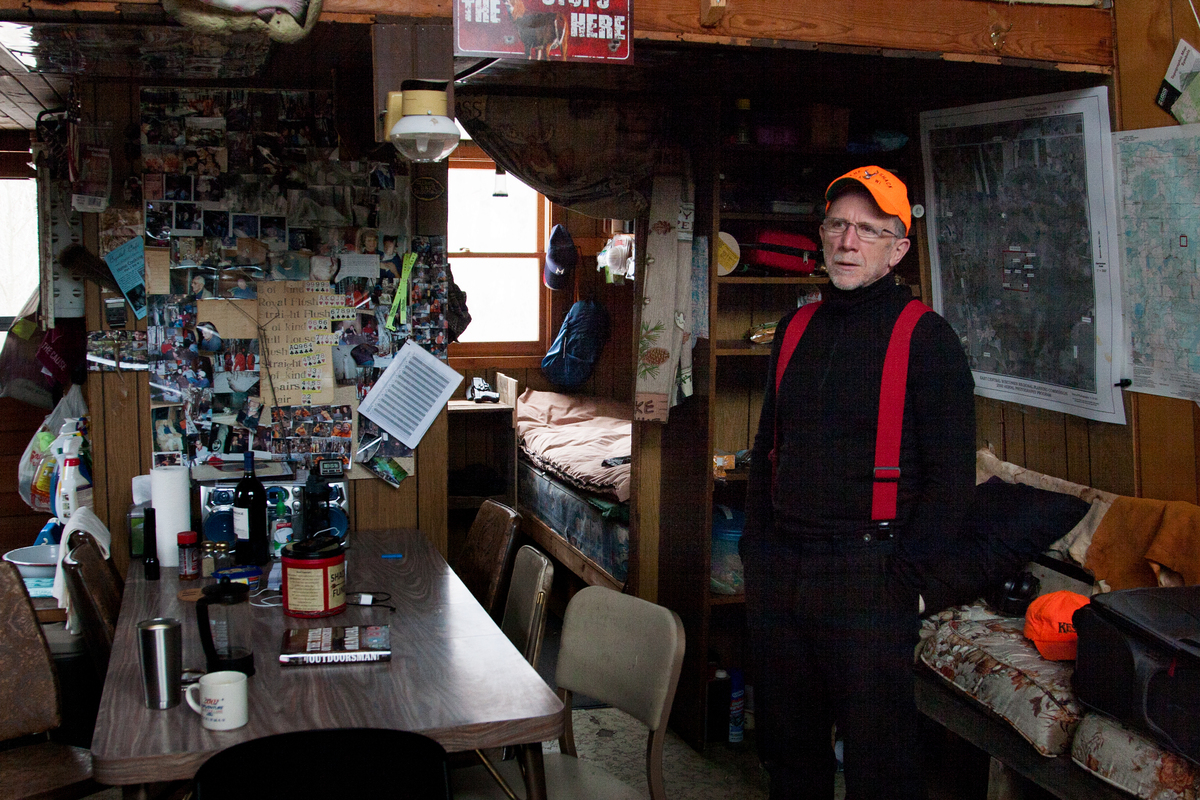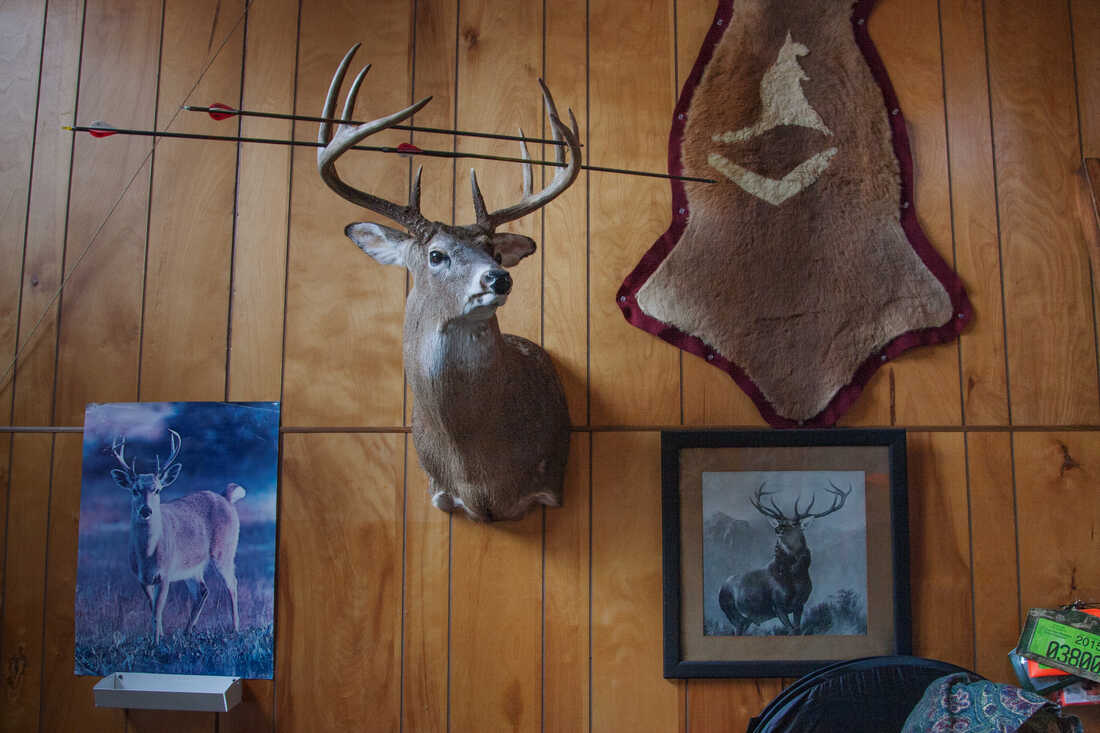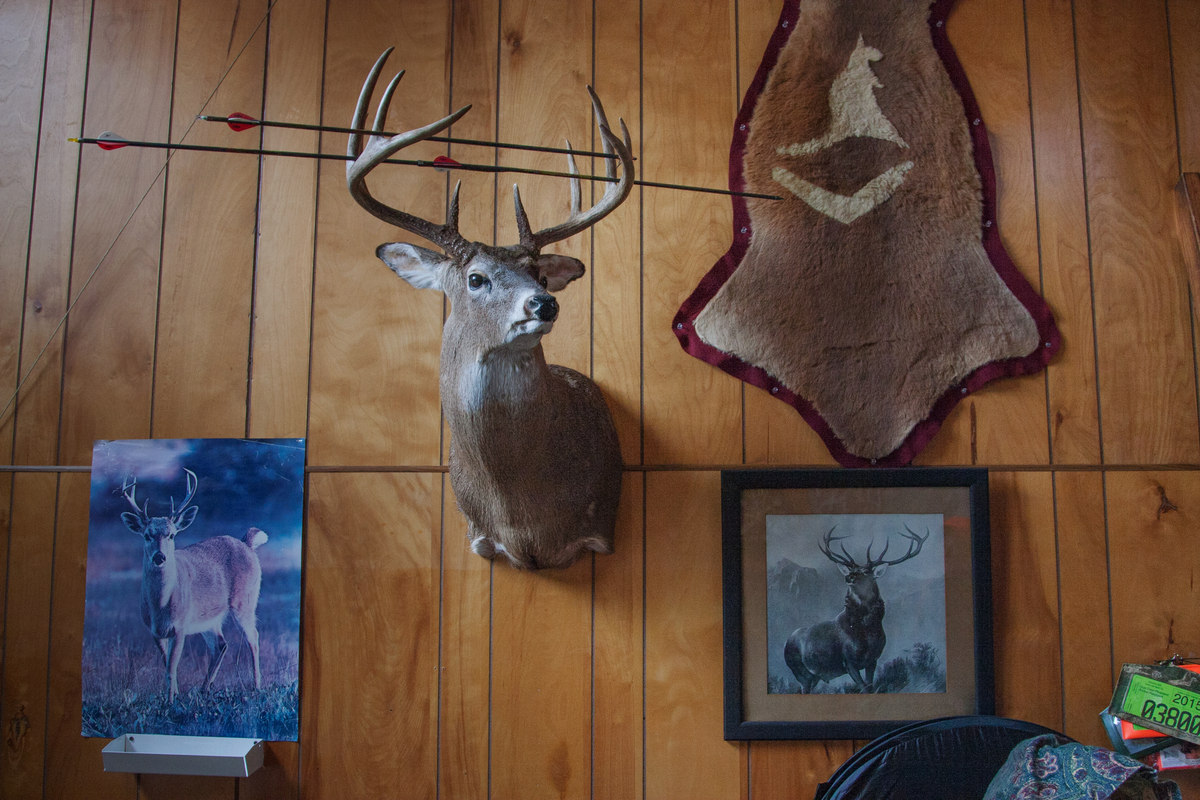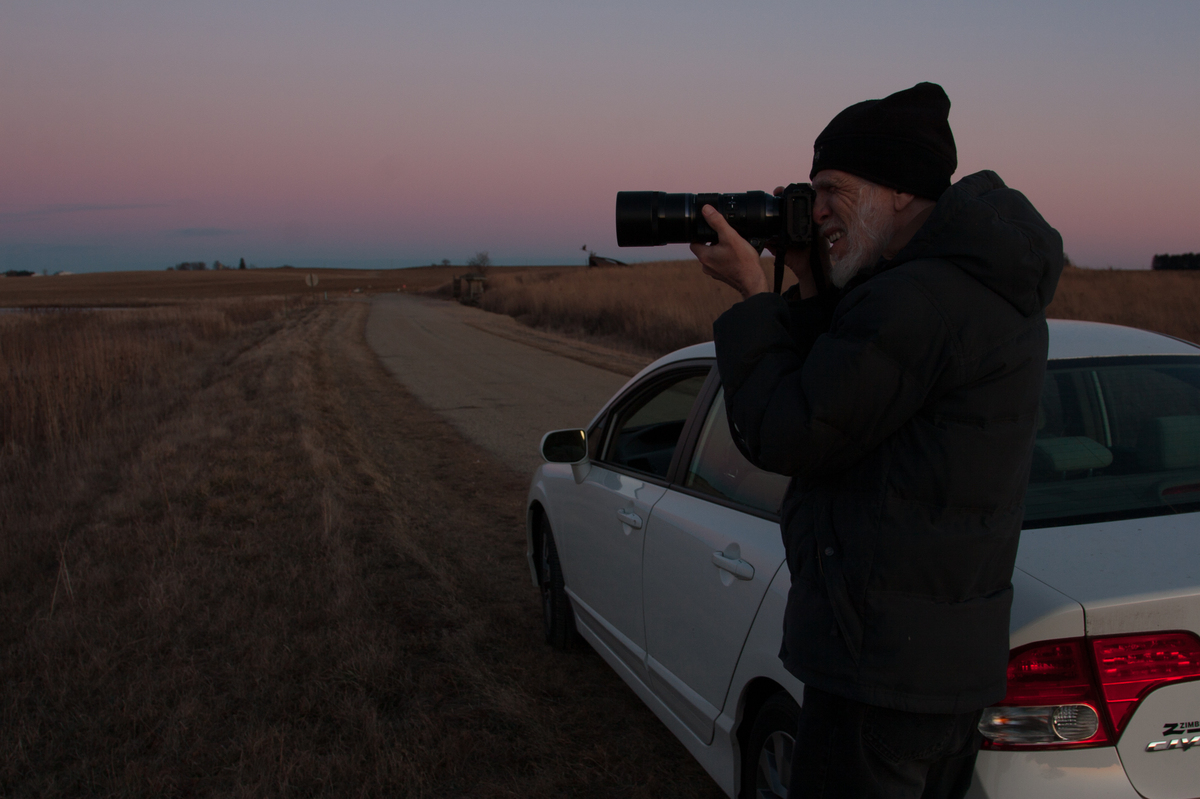Is Hunting Necessary For Animal Conservation 2018
NPR'southward Skunk Bear YouTube
Tom Wrasse is at his hunting shack lone. Light pours into the pocket-sized room from a window framed past antlers, harvested from the surrounding key Wisconsin woods. On the opposite wall is a collage of fading photos, showing how big the hunting parties out here used to be.
"I try to keep the tradition live," Wrasse says, looking at the photos over a cup of java. "Merely no, they've all gone their separate ways."
In rural Wisconsin, the passion for hunting still appears to burn as bright equally the blaze orange jackets you'll see stalking through fields or clambering up into trees during deer season. Simply stop into a meat processing middle or a sporting goods store, ask well-nigh it at a bar or a hunting shack and you'll hear from people like Wrasse: Fewer people are hunting. "It's just kind of fading abroad," he says.
A new survey past the U.Southward. Fish and Wildlife Service shows that today, only well-nigh v per centum of Americans, 16 years old and older, actually hunt. That'south one-half of what it was 50 years agone and the refuse is expected to advance over the next decade.
Loading...
Meanwhile other wildlife-centered activities, similar birdwatching, hiking and photography, are rapidly growing, as American society and attitudes towards wildlife modify.
The shift is being welcomed by some who morally oppose the sport, but it's besides leading to a crisis.
State wildlife agencies and the state's wild animals conservation system are heavily dependent on sportsmen for funding. Money generated from license fees and excise taxes on guns, armament and angling equipment provide nigh 60 percentage of the funding for country wildlife agencies, which manage well-nigh of the wildlife in the U.South.
This user-play, user-pay funding system for wildlife conservation has been lauded and emulated around the world. It has been incredibly successful at restoring the populations of North American game animals, some of which were in one case hunted almost to extinction.

Tyler Hasheider (center) helps double-decker Beth Wojcik (bottom right) on how to clean a deer. They harvested two does during a twenty-four hour period of hunting. Nathan Rott/NPR hide caption
toggle caption
Nathan Rott/NPR

Tyler Hasheider (center) helps coach Beth Wojcik (lesser correct) on how to make clean a deer. They harvested two does during a day of hunting.
Nathan Rott/NPR
Just with the slide in hunting participation expected to speed up in the next x years, widening funding shortfalls that already be, there's a growing sense of urgency in the wildlife conservation community to augment that funding base. Congress is looking at tapping oil and gas revenues. Some states are adding general sales taxes, while others are looking for means to tweak the user-play, user-pay model to better stand for how today'southward social club interacts with wildlife, monetizing activities similar wild animals-viewing.
Those efforts are running into a larger question: Is the greater public willing to pay more than to protect wildlife?
"Conservationists demand to be looking at what is the next step to proceed our conservation programs and places strong and salubrious," says Mary Jean Huston, director of The Nature Conservancy in Wisconsin. "Things need to evolve."
And they need to evolve fast.
In Wisconsin, a lack of funding has prompted the land'southward Department of Natural Resources to leave staff positions unfilled and cut back on habitat management. Colorado'south wild animals agency has cutting tens of millions of dollars in expenditures and trimmed programs that deal with invasive species. Vermont's fish and wildlife department, which manages more than than 25,000 species and nearly 2,000 native plants, is cautioning that fifty-fifty though the state leads the nation in wildlife viewing, that activity "provides no significant revenue stream to the department that would let for the management of the resources viewed."
A panel on sustaining America's fish and wild animals resources recently warned: "Without a alter in the style we finance fish and wildlife conservation, we can look the list of federally threatened and endangered species to abound from nearly ane,600 species today to perhaps thousands more in the future."

Tom Wrasse is alone at his hunting shack on the concluding day of a deer hunting flavor. "I try to keep the tradition alive," he says. Nate Rott/NPR hide caption
toggle caption
Nate Rott/NPR

Tom Wrasse is lone at his hunting shack on the last day of a deer hunting season. "I try to go on the tradition alive," he says.
Nate Rott/NPR
A demographic wall
In 1992, Tom Heberlein, a rural sociologist at the University of Wisconsin-Madison, made a bold prediction: If sociological trends, like increasing urbanization, smaller family unit sizes and growing anti-hunting sentiment connected, the sport of hunting – every bit Wisconsinites knew it – could be extinct by the twelvemonth 2050.
A quarter century after, Keith Warnke, the hunting and shooting sports coordinator for the land of Wisconsin, sits at his desk-bound in downtown Madison looking at a graph of contempo hunter data.
"It's just striking how close demographers were in their estimates to the bodily hunter numbers," he says.
Warnke is a "recovering biologist," as he puts it, so he collects hunter information and demographics – age, gender, location, etc. – with the same detailed focus that he used to employ to tracking deer populations. Only now, he uses unique identification numbers instead of ear tags.

There are stories behind every deer caput and set up of antlers at Tom Wrasse's hunting shack. It'due south rare, he says, to see big bucks in this area anymore though. Nathan Rott/NPR hibernate caption
toggle caption
Nathan Rott/NPR

There are stories behind every deer head and set of antlers at Tom Wrasse's hunting shack. It's rare, he says, to come across big bucks in this area anymore though.
Nathan Rott/NPR
And while he does not believe that hunters will go extinct in the next few decades – or ever, for that matter – he does know a steeper reject in hunting participation is coming, every bit Heberlein predicted.
Increased urbanization, restricted access to huntable areas, lack of gratuitous time, and the ascent of Netflix, video games and all-consuming youth sports are all dropping hunter numbers, but the most-pressing challenge is one that Warnke and others can't practise anything about.
"We're up against a demography wall," Warnke says. "A wall of demographics when the number of hunters is really going to decline."
That wall is an age. Sixty-five. That's when the average hunter stops buying licenses and picking up their rifle, Warnke says.
For many hunters in Wisconsin and around the U.Southward., that wall is quickly approaching.
Nigh a third of all hunters in the U.S. are baby boomers. They hunted like no other generation since. But the oldest Boomers are already aging out of the sport and the youngest, at 54, are only near a decade away from joining them.
This visualization by Dr. Loren Hunt with the Oregon Department of Fish & Wild animals shows the age demographics of hunters through time. Each cavalcade represents the pct of the U.Due south. population that hunts in different age groups from 1992 to 2012.
Dr. Loren Chase, Oregon Section of Fish & Wildlife YouTube
When put on a timeline, that cohort of older hunters looks similar a moving ridge, moving through time, that drops as it hits the historic period of 65.
"What that means is the way that conservation was washed in the past is not going to be sufficient in the future," says Randy Stark, the former main game warden for Wisconsin's Department of Natural Resources, or DNR.
Linking hunting to conservation
To understand the connectedness betwixt hunting and conservation, y'all demand to go dorsum to when deer and geese weren't viewed a public nuisance, but as the rare wildlife they were.
In the belatedly 1800s, American wildlife was in a bad place. Market hunting, trapping, invasive species and American's rapid expansion westward had pushed many wild fauna species to the brink.
All of this over-hunting got the attention of a couple of other hunters – one who would go on to found the Audubon Society, another who would become the 26th and youngest president of the United States.
George Bird Grinnell and Theodore Roosevelt, along with others like John Muir and Gifford Pinchot, helped institute the American conservation movement effectually the idea that wildlife and other natural resource, belong to all Americans – electric current and future. Equally such, they needed to be preserved or conserved.

Emily Iehl and Beth Wojcik set out to detect an open spot to sit and wait for moving deer. Iehl, who works with Wisconsin's DNR is mentoring Wojcik, who has never killed a deer before. Nathan Rott/NPR hibernate caption
toggle caption
Nathan Rott/NPR

Emily Iehl and Beth Wojcik set out to find an open spot to sit and expect for moving deer. Iehl, who works with Wisconsin's DNR is mentoring Wojcik, who has never killed a deer before.
Nathan Rott/NPR
Roosevelt proposed the idea of "conservation through wise apply," and started pushing his fellow hunters to help pay for that conservation.
Licenses or permits for hunting already existed. New York sold the first permit to hunt deer in 1864. Under Roosevelt though, the practise spread and license fees became a source of revenue for states.
Then, in 1937, legislation was passed that linked the financing for wild animals conservation to hunting in a way we're notwithstanding seeing today.
"Nobody could anticipate 100 years after what society would look like," Stark says. "In some ways the way that conservation was funded and conceived in its early years contributes to the problem we have at present."
The Federal Aid in Wildlife Restoration Human action, or the Pittman-Robertson Act, as it'southward more unremarkably known, requires that states utilize their revenues from hunting license fees for wild fauna management. It also took an existing eleven percent excise tax on guns and ammunition and directed that coin to country wildlife agencies for wild animals restoration and protection. A similar human action was later passed to taxation angling equipment.
More than $19 billion has since been apportioned to state wild animals agencies from funds generated by those taxes.
With gun sales surging in recent years, that pool of money has actually grown. People in the hunting world joke that quondam president Barack Obama was the greatest conservationist since Roosevelt, because of the record gun sales during his presidency.
Simply in that location's a catch.
Tightening belts
To admission those federally apportioned funds, states have to pony up some of their own matching money - 25 percent or more than of the full they're looking to get back. No friction match, no coin.
"With decreases in license sales, we're getting to the indicate as a state agency that nosotros're struggling to match those funds," says Eric Lobner, the caput of the wildlife segmentation for Wisconsin's DNR.
Many states have increased license fees for out-of-land hunters to compensate for the decrease in license sales, just Lobner says there's merely so far you can raise fees before you kickoff pricing people out.

Mitch Mode, the owner of Mel's Trading Postal service in Rhinelander, Wis., has watched as people'due south outdoor interests take shifted towards sports like cross-state skiing and bicycling. Fewer customers buy hunting gear these days, he says. Nathan Rott/NPR hide caption
toggle explanation
Nathan Rott/NPR

Mitch Fashion, the owner of Mel's Trading Mail service in Rhinelander, Wis., has watched as people'due south outdoor interests have shifted towards sports similar cantankerous-land skiing and bicycling. Fewer customers buy hunting gear these days, he says.
Nathan Rott/NPR
At the aforementioned fourth dimension, he says, the price of doing business organisation is going up and the demands on his agency are growing. Climate change and development are threatening more species. The public wants protections for animals that information technology used to not care about. The combination is creating a crunch.
The National Wild animals Federation, a nonprofit conservation organization, says that current funding levels for national wildlife conservation are "less than 5 pct of what is necessary."
In Wisconsin, Lobner says, they've had to cutting sixteen positions in their program considering of budget shortfalls over the last iv years - people who would have been managing wildlife and habitat. Open positions are staying vacant longer. Programs and services are being scaled back.
In a report to the Wisconsin legislature'southward Articulation Committee on Finance, the DNR listed several ongoing or potential reductions due to insufficient funds, including fewer game warden patrols, less habitat direction, fewer fish surveys and 2,000 acres of shallow wetlands that are being left unmanaged.
Wetlands that, as Lobner points out, don't just serve as wild fauna habitat but also assist to purify the state's drinking water.
"These are resources that the public wants," Lobner says. "We've been hearing they desire to run across waterfowl, they want to encounter deer, they want to encounter conduct, whatever the species information technology is. They desire those resources at their disposal."
The question is: Are they willing to pay for them?
Hunting for more funding
Public back up for hunting remains high across the country, fifty-fifty with fewer people participating. Public support for wildlife conservation is even higher.
Almost 90 percent of Wisconsin residents - Republicans, Democrats and Independents - concord that coin should be invested in protecting land, water and wildlife fifty-fifty when the state'due south budget is tight, according to a poll commissioned by the land's chapter of The Nature Conservancy.
Nationally, 74 per centum of Americans believe the country should "practice whatever it takes to protect the surround," co-ordinate to the Pew Research Heart.
Just in well-nigh cases outside of hunting and fishing, that's non beingness translated into dollars.
Philanthropy and nonprofits take certainly stepped up to attempt and fill the void, bringing in money for habitat purchases and management. A few states have passed sales taxes to aid fund conservation. Others have tapped lottery ticket sales or started selling specialty license plates.
Even Congress is looking for a solution. Legislation, introduced belatedly concluding twelvemonth, would redirect revenues from free energy and mineral development on federal lands to state wildlife programs. The proposal has bipartisan support, simply like efforts to secure wider funding take failed in the by.
So in most cases, state wildlife agencies like Wisconsin'south are going back to the hand that feeds them, doubling down on hunters with programs to retain quondam hunters, reactivate those who have quit the sport and to recruit new hunters.
For the latter, state wildlife agencies are increasingly looking for new hunters that don't fit the traditional mold past advertising in urban areas, opening stands at farmers markets and staffing community events. In Wisconsin, they're offering free classes on college campuses, teaching hunter's condom and hands on butchering clinics, with the goal of capitalizing on the locavore movement and a renewed involvement in wild meat.

A grouping of hunters get together in southern Wisconsin for a late flavor antler-less deer hunt. Nathan Rott/NPR hide caption
toggle caption
Nathan Rott/NPR

A group of hunters assemble in southern Wisconsin for a late season antler-less deer hunt.
Nathan Rott/NPR
These efforts are having success, Warnke says, especially in recruiting women to the sport.
"But when yous look overall, our small group isn't going to modify the tendency," says Jim Wipperfurth, a volunteer for Wisconsin's DNR who leads recruitment hunts. "There'southward just and so many factors involved, it's hard to just change it."
This pains Wipperfurth and other hunters to say. Information technology's not just the loss of a sport or a revenue source they're trying to finish, but the loss of a tradition and a connexion to the natural globe, Wipperfurth says.
"Who goes and sits in the woods all twenty-four hours except hunters?" Wipperfurth says. "If hunting didn't exist, who'd know that the squirrel population is down, that a windstorm knocked all these copse downwardly - who'd know all of that stuff? Because we're the ones out here seeing all of information technology."
The latest numbers from the U.S. Fish and Wildlife Service testify that 86 million Americans participated in wildlife watching in 2016. That was a twenty percent increase from just v years previous. The number of people enjoying outdoor recreation is increasing also.
"We need to find ways for the residual of those folks, who are boating and cross country skiing and biking and going to the park to contribute likewise," Huston says.
There have been efforts to tax outdoor equipment like sleeping bags, tents and binoculars. Some in the wildlife management globe joke most an "REI Taxation," a reference to the chichi outdoor retailer.
Those efforts have failed though, in large part because of opposition from the outdoor manufacture, which argues that it already pays billions of dollars in taxes through import tariffs. That revenue should be used to fairly fund conservation, says the Outdoor Industry Association, a merchandise group that represents retailers like Patagonia and The North Face up.
The arguments virtually funding for conservation can quickly grow divisive. Hunters are quick to write off other outdoor recreationists every bit hippies and "gratis riders." Wild fauna advocates are quick to pigment hunters as hillbillies, clinging to an outdated tradition. But many people are in the eye.
"Wildlife conservation has been at its strongest when hunters and not-hunters are allied together for wildlife," says Adena Rissman, an associate professor of woods and wild fauna environmental at the University of Wisconsin.
The passage of the Lacey Human activity, the nation'south showtime - and maybe most powerful - wildlife protection law is a good instance, Rissman says. It prohibits the trade of wildlife, fish and plants that have been taken illegally.

Neal Deunk photographs geese at a wildlife refuge north of Madison, Wis. Nathan Rott/NPR hide caption
toggle caption
Nathan Rott/NPR

Neal Deunk photographs geese at a wild fauna refuge north of Madison, Wis.
Nathan Rott/NPR
That act, Rissman says, was galvanized not simply by hunters, merely past affluent women's groups that had grown concerned about the millinery trade'due south impact on bird populations. Feathered hats were in manner in the late 19th century and hunters were killing millions of birds annually, wiping out entire colonies, to feed the demand. Sport hunters, angry nigh the pitiful state of their quarry, were as concerned. Together, they helped push lawmakers to a legislative solution.
A similar collaborative endeavor is needed to address the funding problems of today, Rissman says, and she believes that other wild animals lovers are willing to contribute.
Well-nigh xx miles north of Madison, at a quiet, open up wildlife sanctuary, Neal Deunk takes pictures of four lonely geese floating on a tiny patch of open water in an otherwise frozen pond. His telephoto lens juts out from the open driver'southward side window of his machine.
Deunk knows the challenges facing wild fauna refuges like this, with the reject in hunting and shrinking revenues. He says he'd like to see lawmakers allocate more general tax money to address the state of affairs. But he likewise thinks information technology would exist prudent to get other wildlife enthusiasts to contribute more.
"It's difficult to license birdwatchers or hikers then forth in the same manner that hunting and fishing tin be regulated," he says, watching as a few of the geese take flying. Asked if he'd exist willing to pay a license-fee to view wild fauna like this, he pauses. "I remember I would," he says.
Source: https://www.npr.org/2018/03/20/593001800/decline-in-hunters-threatens-how-u-s-pays-for-conservation
Posted by: hutchesonmationdeed.blogspot.com

0 Response to "Is Hunting Necessary For Animal Conservation 2018"
Post a Comment